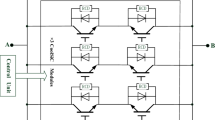Abstract
To enhance nominal current of high voltage vacuum circuit breakers (VCBs), a gravity heat pipe was proposed to replace stationary conducting rod of a high voltage vacuum interrupter. The heat pipe is composed of two coaxis tubes: the external tube is made of oxygen-free copper and the inner tube is made of stainless steel. The bottom end of the inner stainless steel tube is connected to the external copper tube by holes. Transient and static thermal performance of the heat pipe was measured, and the thermal resistance of it was compared with that of a solid copper rod with the same dimensions. Experimental results showed that thermal resistance of the heat pipe was about 1/3 of that of the copper rod, and it decreased slightly with the rising of the input heat flux. 3D thermal simulation on a 126 kV/2000 A single break VCB was done to compare the thermal performance between the proposed gravity heat pipe and the copper rod serving as the stationary conducting rod of the vacuum interrupter. Simulation results revealed that in the heat pipe case, the maximum temperature between contacts was 67 °C lower than that in the copper rod case.
Similar content being viewed by others

References
Feldman, J., Srinivasan, R., 1984. Investigation of Heat Transfer Limits in Two-phase Closed Thermosyphon. Proceedings of 5th International Heat Pipe Conference, Tsukuba, Japan.
Fink, H., Gentsch, D., Heimbach, M., 2003. Multilayer contact material based on copper and chromium material and its interruption ability. IEEE Transaction on Plasma Science, 31(5):973–976. [doi:10.1109/TPS.2003.818425]
Liu, Z., Wang, J., Xiu, S., Wang, Z., Yuan, S., Jin, L., Zhou, H., Yang, R., 2007. Development of high voltage vacuum circuit breakers in China. IEEE Transaction on Plasma Science, 35(4):856–865. [doi:10.1109/TPS.2007.896929]
Martens, T., Nellis, G.F., Pfotenhauer, J., Jahns, T., 2005. Double-sided IPEM Cooling Using Miniature Heat Pipes, IEEE Transactions on Components and Packaging Technologies, 28(4):852–861. [doi:10.1109/TCAPT.2005.848591]
Matsui, Y., Saitoh, H., Nagatake, K., Ichikawa, H., Sakaki, M., 2005. Development of Eco-friendly 72/84 kV Vacuum Circuit Breakers. Proceedings of International Symposium on Electrical Insulating Materials, Kitakyu-shu, Japan, 3:679–682. [doi:10.1109/ISEIM.2005.193461]
Matsukawa, M., Miura, Y., Kimura, T., Watanabe, K., Kubota, T., Kawashima, S., 1998. Design and model test of a water-cooled VCB for superconducting magnet power supplies. Fusion Technology, 34(3):684–688.
Matsukawa, M., Miura, Y., Terakado, T., Kimura, T., 2000. Development of a Vacuum Switch Carrying a Continuous Current of 36 KA DC. IEEE 19th International Symposium on Discharges and Electrical Insulation in Vacuum, Xi’an, China, 2:415–418. [doi:10.1109/DEIV.2000.879015]
Okubo, H., 2006. Development of Electrical Insulation Techniques in Vacuum for Higher Voltage Vacuum Interrupters. IEEE 22th International Symposium on Discharges and Electrical Insulation in Vacuum, Matsue, Japan, p.7–12.
Renz, R., 2006. High Voltage Vacuum Interrupters; Technical and Physical Feasibility versus Economical Efficiency. Proceedings of 22nd International Symposium on Discharges and Electrical Insulation in Vacuum, Matsue, Japan, p.257–262. [doi:10.1109/DEIV.2006.357281]
Wang, J., 2006. 126 kV Vacuum Circuit Breaker Debuted in China. IEEE 22th International Symposium on Discharges and Electrical Insulation in Vacuum, Matsue, Japan, p.1–5.
Xie, H., Ali, A., Bhatia, R., 1998. The Use of Heat Pipes in Personal Computers. The Sixth Intersociety Conference on Thermal and Thermomechanical Phenomena in Electronic Systems, Seattle, American, p.442–448. [doi:10.1109/ITHERM.1998.689600]
Yamano, Y., Kobayashi, S., Matsukawa, M., 2002. Measurements and Analysis of Temperature Rise at Electrodes of a Vacuum Interrupter for High Current Applications. IEEE 20th International Symposium on Discharges and Electrical Insulation in Vacuum, Tours, France, p.419–422. [doi:10.1109/ISDEIV.2002.1027398]
Yanabu, S., 2006. Historical review of high voltage switchgear developments in the 20th centurary for power transmission and distribution system in Japan. IEEE Transactions on Power Delivery, 21(2):659–664. [doi:10.1109/TPWRD.2005.861228]
Zaghdoudi, M., Teytu, A., 2000. Use of Heat Pipes for Avionics Cooling. Proceedings of 3rd Electronics Packaging Technology Conference, Singapore, p.425–430. [doi:10.1109/EPTC.2000.906411]
Author information
Authors and Affiliations
Corresponding author
Additional information
Project (No. 200806981005) supported by the New Teacher Foundation of MOE, China
Rights and permissions
About this article
Cite this article
Yu, Xl., Liu, Zy., Feng, Qk. et al. A gravity heat pipe for high voltage vacuum interrupter. J. Zhejiang Univ. Sci. A 10, 1305–1312 (2009). https://doi.org/10.1631/jzus.A0820724
Received:
Accepted:
Published:
Issue Date:
DOI: https://doi.org/10.1631/jzus.A0820724



